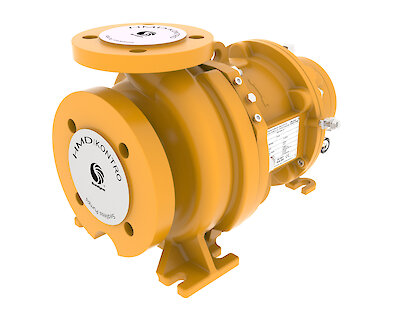 Sealless pumps – The best option for safety, reliability and efficiency
Sealless pumps – The best option for safety, reliability and efficiency
By Darren Martin, Global Product Line Manager, HMD Kontro Sealless Pumps
Managing risk in manufacturing and processing is an important issue, especially for the chemicals industry. With complex operations often involving the transfer of highly toxic or corrosive materials or where the constituent elements being mixed are hazardous, extreme caution is required. The type of pumps you use can greatly reduce the risk of pump leakage as well as offering lifetime cost benefits.
Globally, increasingly stringent environmental regulations and tougher safety standards are focused on avoiding the release of dangerous products into the atmosphere. Breaches of compliance not only have a human and environmental cost but could also affect the company’s reputation. From an operational standpoint, any disruption of production may also incur unexpected costs, with potentially damaging financial implications where the loss of high value product or business continuity are involved.
Conventional mechanical seal pumps have been used by the chemicals industry for many years. Most of these pumps are designed to leak: some form of seepage is essential for the seals to operate. However, this introduces an inherent risk. If the seal fails, the product being pumped could be released into the environment. In fact, up to 85% of unexpected pump failures can be attributed to issues with mechanical seals.
 Switching to sealless magnetic drive pumps will result in no leak paths while their containment components boast an extremely high
Switching to sealless magnetic drive pumps will result in no leak paths while their containment components boast an extremely higher reliability than traditional sealed pump designs.
Sealless magnetic drive pumps have been in operation for decades, yet to some extent, they remain a niche solution for solving hazardous pumping applications. Part of the reluctance of some engineers towards this well-proven technology is down to the legacy of early historical failures. However, new technologies and materials have long since been applied to perfect magnetic drive sealless pump technology, so addressing these issues.
A key concern with early iterations was centred around the use of metallic primary containment devices and the eddy currents that are induced into the stationary metallic containment shells because of the driving magnetic field rotating around it. Modern sealless pumps incorporate design developments which effectively address this in three ways:
Elimination of induction losses with the use of a composite containment shell
Composite containment shells are nonconductive and therefore will not result in eddy currents from the magnetic flux passing across them, thus preventing heating and mitigating induction losses. Chemically resistant and exceptionally tough, they feature fire, erosion and impact tolerance that in many cases are superior to metallic options. This type of pump is particularly suited for use with chemicals that are toxic, pungent, corrosive, extremely hot or cold or are especially hazardous.
 Use of instrumentation to detect and shut down the pump when causal factors are present
Use of instrumentation to detect and shut down the pump when causal factors are present
Recent technology gains include HMD Kontro’s patented VapourView technology, which ultrasonically detects the presence of gas in a liquid stream from outside the confines of the pump pressure boundary. Such ultrasonic instruments can detect gas bubbles on the order of less than 1 percent by volume.
Mitigating the risk of the pump leaking at all with secondary containment/control
The latest sealless pumps also offer a solution to more recent regulations mandated under ASME and ISO standards which require the option of a secondary control or containment system. Compliance can easily be achieved with the inclusion of a leakage restriction / containing device on the motor shaft (close coupled) or drive shaft (long coupled).
A Cost-Effective Proposition
Capital expenditure is an obvious consideration when planning a new installation or upgrading and replacing pump systems. With sealless pumps perceived as more costly due to their upfront cost, specifiers have in the past gravitated towards conventional pumps. However, when evaluated on a whole life basis, sealless pumps can reduce ongoing maintenance and servicing costs considerably, making for a much lower total life cost.
With fewer working parts and no associated mechanical seal support systems, the magnetic drive design is easier not only to specify and install but also to maintain. Reducing the risk of dry running for bearings also helps extend pump working life. The modular design of HMD Kontro’s newest CSA/CSI range of pumps is an example of how manufacturers are addressing user concerns and also enabling future on-site upgrades.
Maximum interchangeability of parts and standardised components enables the number and size of different pumps to be reduced and so helps minimise spares holding requirements. A simplified design which eliminates hot working means servicing and maintenance can be carried out on site without the need to access outside services.
Energy efficiency is increasingly an issue. Another barrier to the adoption of sealless pumps is the perception they use more energy and are more costly to run. In fact, sealless pumps now offer high efficiencies delivering a low energy solution. The elimination of heat generation in the latest zero loss containment shells developed by HMD Kontro, for example, also enables smaller motors to be specified, with a 20% reduction in power consumption.
Getting to grips with sealless pumps: HMD Kontro has introduced a new section to its website with additional learning resources to help build awareness of magnetic drive sealless pumps and assist specifiers less familiar with the technology. To access this information, please visit www.think-sealless.com

